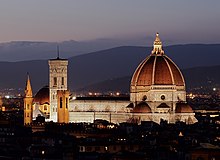Climbing Uluru is often compared to climbing a Cathedral, and some contend that you wouldn't climb a Cathedral so why climb Uluru. The only problem is that virtually all Cathedrals of note are open for climbing. Some for free, some for a small fee. Christian churches are among the most welcoming to pilgrims, visitors and tourists and allow access to virtually all parts of their places of worship. Photography is welcome. Contrast this to Uluru where climbing is shortly to be banned and access to sacred sites is highly restricted. At Uluru restrictions on photography are enforced with a weird rabid fervour characteristic of fundamentalist cults.
Here's a list of 10 great Catherdrals to put on your climbing list. They are in no particular order.
1. St Pauls Cathedral, London
St Paul's is built in the shape of a cross, with a large dome crowning the intersection of its arms. At 111.3 metres high, it is one of the largest cathedral domes in the world and weighs approximately 65,000 tons. The area under the dome is the principal place for worship in the Cathedral.
Now that the repairs and upgrades have been be completed we are able to able to open the tower to visitors so they can experience the 360 degree views which extend up and down the coastline and across the entire city including the bustling harbour.
The church is situated on top of a hill. The inside is very nice, beautiful but not over-the-top. When visiting, I strongly suggest climbing the bell tower. We actually had trouble finding where to start the climb. We looked inside the church, walked the perimeter and finally discovered the entrance inside the church on the left hand side near the altar. My fear of heights was severely tested on the climb! The stairs go round and round and the treads are old wooden slats that vary in width. They are open to below and it is very disorienting (especially when descending). However, it's worth every scary moment when you reach the top and see the views!
Here's a list of 10 great Catherdrals to put on your climbing list. They are in no particular order.
1. St Pauls Cathedral, London
St Paul's is built in the shape of a cross, with a large dome crowning the intersection of its arms. At 111.3 metres high, it is one of the largest cathedral domes in the world and weighs approximately 65,000 tons. The area under the dome is the principal place for worship in the Cathedral.
‘This was fun the first time I did it – but magical the second time, because my five year old son was with me. The Whispering Gallery with a child … Pure joy!’
2.Westminster Cathedral Tower, London
Spectacular views over London from Viewing Gallery 64 metres (210 feet) above street level.
Take as much time as you like to experience the vibrant atmosphere, sounds sights and ever-changing light of our city, in a safe, unhurried environment.
4. St. Peter’s Basilica Dome, Vatican
Once you pass the security control and access the Basilica, you will finally see its architecture and magnificent works of art. From all the things you can do, we recommend one: climb up to the dome in St Peter’s, the work of the genius, Michelangelo.
St Peters
5. St James’ Church Bell Tower, Sydney
Sydney Open visitors will be able to access areas not normally open to the public. Climb the tower stairs to the gallery and bell-ringing area, then ascend to the roof above the nave and bell chamber before reaching the top of the tower, where you’ll see the original timber mast supporting the spire. Along the way, learn something of St James’ extraordinary history and the people who created, adapted and now care for this heritage icon.
 Photography allowed!
Photography allowed!
7. Church of St. George, Slovenia
Perched high above Tartini Square, the Church of St. George's bell tower lures visitors up from the town center. After paying your admittance fee, you can climb to the top of the bell tower on rickety, narrow, uneven steps - which makes this even more of a fun adventure. The bells in the tower chime every 15 minutes and on the hours, so either time your climb up and down so that you avoid the deafening sound or are there to enjoy the musical magic. The views from the top of the tower down to Tartini Square and the Adriatic are simply stunning.
8. Florence's Cathedral, the Duomo, Italy
After seeing the Duomo from all sides and visiting the inside of the cathedral, all you need to do to complete the experience is climb to the top of the cupola! The only way to see the inside of the dome up close and enjoy the extraordinary view of Florence it offers is to climb its 463 steps (there is no elevator): the route takes you by the interior of the dome where you can admire Giorgio Vasari's frescoes of the Last Judgment (1572-9) up close.
Florence Cathedral
9.The towers of Notre-Dame Cathedral, Paris, France
Climbing on the towers of Notre-Dame is a must-to-do thing when visiting monuments in Paris. At the heart of Paris, built the Île de la Cité from 1163, the majestic and elegant Gothic cathedral allows visitors to reach the Chimera gallery and the top of the South tower with breathtaking views over the city to enjoy in the company of eerie beasts.
10. Washington National Cathedral, USA
Climb to the dizzying heights of the Cathedral for the best views of Washington and up-close encounters with massive bells and gregarious gargoyles. Options include 333 steps up the Central Tower, intimate views of gargoyles—or both!



Comments
Post a Comment